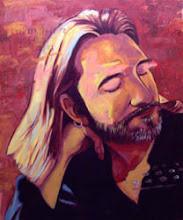My Electroencephalography Appointment
| Electroencephalography (EEG) is nothing more than a graphical reading of the firing of neurons in the brain as they are picked up through the scalp with electrodes. It is generally a painless process, although the placement of electrodes with water soluble glue can be uncomfortable, especially if you are sensitive to strangers touching your head. My technician turned out to be quite personable with a good bedside manner. When she put on the electrodes she began by marking my head at cranial nodes with a grease pencil, covering the entire crown, which tickled a bit. Then as she glued each electrode down she scrubbed the scalp vigorously to minimize oils and maximize adhesion. This actually hurt a little, but didn't last long enough to complain about. Once that was complete she turned off the light in the room and set up a strobe light which is the first test. Successively increasing the frequency of the strobe, she asked me to close my eyes and then shone a flashing light onto my eyelids. The effect is amazing. I have closed my eyes before in a nightclub where there are strobe lights and never saw this particular visual effect. What I experienced was similar to looking down a tube that had a black and white checkerboard projected onto it. In between each strobe, they had me open my eyes and then close them again before they increased the strobe frequency. As the frequency increased the visuals gradually changed incorporating color and other effects more difficult to explain. At the highest frequencies the effect was a grainy gray pattern, similar to looking too close at a rough wall. Many years ago I met a Seattle artist who was inspired by the visuals encountered during an EEG and incorporated the checkerboard effect into her paintings. I have looked for her work online but haven't come up with anything, otherwise I'd include an image for you. But they are very distinctive; swirling checkerboard patterns in blue and white with goldfish and flowers floating between. It never occurred to me how what she painted could be due to an EEG until I experienced it myself. Anyway, in the next test, I was asked to breath heavy until I hyperventilated. After doing the heavy breathing for several minutes you do experience tingling sensations in your hands and feet and feel light headed, but it isn't as unpleasant as the few times I've actually hyperventilated while exercising. Perhaps because I was lying down already, I didn't experience any queasiness or see lights. Thankfully this test didn't take long. The final test is done with the lights off and they encourage you to attempt to sleep. In preparation for the EEG, I was asked to limit my sleep the night before to about four hours so I was already feeling groggy that day. I didn't fall unconscious during this last test. It has been several years since I've attempted to sleep in the city and every five minutes or so a siren would sound or a train would whistle or a truck would honk its horn. My technician did say she was able to collect enough data from my sleeping period. And the good news is that my Neurologist said my results were normal. I am now scheduled for a brain MRI this next Sunday and this will be a defining test. Apparently when my head was scanned at the emergency, they were only looking for internal bleeding, which is called a CT scan. This is all at the grace of Swedish Medical's Access program, which I am very grateful to have qualified for. | |



